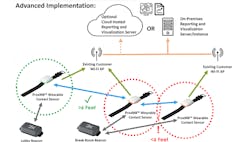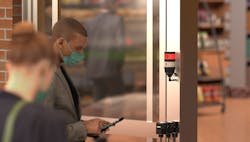Wi-Fi, photoelectric and ultrasonic sensing monitor social distancing
Because many users are hesitant to turn on location services on their smart phones or tablet PCs, and may be equally reluctant to share similar data with their employers or customers, they might be more willing to accept social distancing technology based on contact sensors, according to Sam Hoff, CEO of Patti Engineering, a CSIA-certified system integrator in Auburn Hills, Mich. Users are given a fob with Patti's patent-pending ProxM8 wearable contact sensor, which detects when users are within 6-8 feet by serializing and cross-referencing their locations (Figure 1). This method is reported to be simpler to implement and less costly because it uses each facility's existing Wi-Fi network, so no added antennas or other hardware are needed. The fobs are available with a monthly subscription, and report their data to ProxM8's dashboard software that compiles user locations, contacts with others, and clusters or heat maps of individuals, which indicates who else may have been exposed if an infection is identified later.
"Every client knows they're going to get some COVID-19 cases, so the question is how to limit and control them without sending whole departments home," says Hoff. "Personal Apple and Android devices have locating capabilities, but the problem is users may not let managers and clients track them.
"Much of what needs to be done about COVID-19 is common sense, plus using good contact tracing tools in facilities. However, we need to do it without intruding into people's phones. This situation isn't going to go away soon, so we have to be prepared for what's coming. Even if the pandemic does dissipate, something similar could emerge in a couple of years, so we can still make use of a solution that enables people to keep working."
Ultrasonics for precision
To further improve the resolution and accuracy of location and distancing technologies, TDK Chirp Microsystems reports it's developed an ultrasonic range-finding and tracking method. David Horsley, CTO at Chirp, reports it's ultrasonic devices typically replace infrared (IR) sensing for more precise range measurement, accurate positioning, presence detection and collision avoidance. It's based on a microelectromechanical (MEMS) transducer with a application-specific integrated circuit (ASIC) in a 3.5 x 3.5 mm package, achieves 1 cm accuracy at ranges from 1 cm to 5 m, employs a wider angle than IR sensing, and consumes very little power. Chirp’s partner, RSAE Labs, is using Chirp’s ultrasonic sensor in a wearable Social Distance module, which communicates by using RSAE’s encrypted Mobile Integrated Sensing Technology (MIST) wireless protocol.
"Sound waves are slow, making it easy to measure range using time-of-flight, which helps make ultrasonics power-efficient and accurate," says Horsley. "Now we're doing social distancing, and Chirp's ultrasonic technology can address it without a lot of challenges because ultrasound won't detect people separated by walls, windows, partitions or other barriers. This is a particular problem for tracking system providers trying to do social distancing with mobile phones and other radio frequency (RF) technologies because their RF signals will pass through these barriers, reporting false-positive contact between people who are safely separated. Range accuracy is also very important—even ultra-wideband (UWB) only goes down to 20 cm, while Bluetooth is only accurate to a couple of meters. All of this means more false positives and frustration than ultrasonics."
In RSAE’s wearable module, two of Chirp's off-the-shelf sensors are fitted to the chest and upper back of the user, along with their transponder and 60-day battery pack, which avoids false positives and provides accuracy within inches, documents for contact tracing, and communicates via MIST protocol. "This arrangement turns every wearer into a wireless router node, which makes the overall mesh network more robust," says Randy Shepard, CEO of RSAE Labs.
"The pandemic has created a sense of urgency," adds Joseph Bousaba, president of Chirp Microsystems. " Everyone wants to return to normal, and highly accurate range finding technology from Chirp’s used in distancing tags from partners like RSAE and others can help provide it."
Figure 2: Banner Engineering combines two connected photoelectric sensors with software and an algorithm to compare results and determine what direction people are moving as they enter a space. Its solution also includes wireless communications and a DXM controller to take time-stampled data from the sensors and deliver an alert on a stack light it the number of people going in exceeds a preset threshold. Source: Banner Engineering
Counting tracks human density
Thanks to its long experience with manufacturing, material handling and logistics applications, Banner Engineering Corp. reports it can focus intently on the mobility, untethered communications and functional visibility needed to improve workflows and productivity—or cope with the social distancing required by COVID-19.
"We're redefining mobility by adding occupancy and sanitation capabilities because many customers aren't just talking about getting back to work after the pandemic, they're also struggling with strategies for reopening during it," says Todd Hanson, industrial wireless director at Banner. "They're trying to comply with ever-changing external rules, keep workers safe, and ramp productivity back up, so Banner is concentrating on how to help solve these problems."
Hanson explains some users are trying to limit the number of people entering defined spaces by manually counting them, which is costly and subject to human movements that are typically unpredictable. "We thought this could be solved by sensing, so we began testing some of the available technologies at a local coffee shop and submarine sandwich shop near our offices in Plymouth, Minn., where people were having to wait outside," says Hanson. "We found each sensing method had some kind of Achilles heel, but we also learned that we could adapt existing technology to determine traffic flow, and vastly improve on the accuracy to help managers maintain an acceptable occupancy level within a space."
In the wake of its research, Banner developed a solution using two connected photoelectric sensors that were combined with software and an algorithm, which let them compare results and determine what direction people are moving as they enter the space (Figure 2). It also includes wireless communications and a DXM controller programmed to take time-stamped data from the sensors, and deliver an alert on a stack light if the number of people going in exceeds a preset threshold. This kitted solution can be installed and working in less than 15 minutes.
"The more we can make this a drop-in solution, the better," adds Hanson. "So far, it works great, and we're getting positive feedback from the retail stores and office spaces, where they're seeing ROI in weeks. We've also expanded it for use in larger facilities, such as schools, colleges, fitness centers, rest rooms, locker rooms and industrial sites. The time-stamped data also lets users tracks peaks and valleys in their traffic, which they can use to adjust staffing levels and cleaning or maintenance schedules. It also provides business analytics when comparing traffic to point of sale."
About the Author

Leaders relevant to this article:



